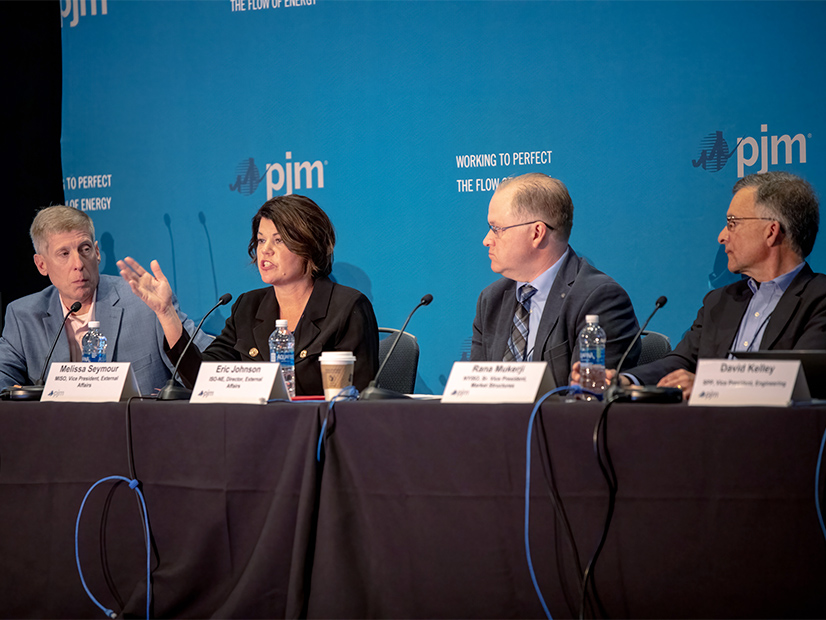
CAMBRIDGE, Md. — A top White House security official urged participants in PJM’s General Session to engage in closer collaboration with RTOs, infrastructure owners and law enforcement at all levels as cyber and physical security threats morph.
“We need to think about how in this changing environment we can enhance our resilience — not just on the grid, but other critical infrastructure sectors,” said Caitlin Durkovich, deputy homeland security adviser for resilience and response.
The growing prevalence of renewable resources on the grid and new transmission technologies will increase the use of networked devices on the grid, which Durkovich said will bring new capabilities but also potentially create vulnerabilities for attackers to exploit.
Part of expanding grid security at all levels will involve a “Madison Avenue campaign” to educate the public, critical communities in particular, about the infrastructure they rely on. By increasing people’s ability to be more self-sufficient, she said first responders can focus on the most important aspects of their response to an emergency, be it a security issue or related to the impacts of climate change.
“It is a remarkable engineering feat, especially as you think about the number of … dependencies and interdependencies,” Durkovich said of the electric grid. “I think we’re at a point where we have to do a better job of helping Americans understand … the increasing threats that we’re dealing with.”
The Biden administration is currently working on updating the 2013 Presidential Policy Directive 21, which defines the responsibilities of government agencies and private companies in maintaining the security of critical sectors, as well as creating bridges for collaboration. The 2021 cyberattack on Colonial Pipeline was an instructive moment for the Department of Homeland Security, which Durkovich said has been working to create new communications infrastructure to allow for tighter collaboration between infrastructure owners and law enforcement. (See Glick Touts Gas Pipeline Reliability Organization Before Congress.)
In addition to strengthening security guidelines, she recommended that companies reach out to state and local law enforcement to identify ways of collaborating. Many of those agencies have received federal security funding and are also in the process of expanding their own practices or creating new programs, which could benefit from knowledge about the infrastructure within their jurisdictions. Recent attacks on substations have also highlighted the need for enhancing physical security, and Durkovich recommended companies reach out to report any suspicious activity.
RTO Panelists Discuss Experiences
A panel of top officials from CAISO, MISO, ISO-NE, NYISO and SPP discussed their experiences navigating the clean energy transition and how they’ve addressed challenges that would be familiar to PJM stakeholders, including how to accredit burgeoning renewable energy, resource adequacy concerns, and the siting and cost allocation for the transmission needed to interconnect intermittent resources.
Melissa Seymour, MISO vice president of external affairs, said the RTO has seen a dramatic evolution from a fairly homogenous grid powered by dispatchable coal resources to a more balanced and diverse fleet. Looking at the projects that are expected to be built in the coming years, however, she said it’s likely to become dominated by resources with limited ability to be dispatched. The margin between the accredited capacity on MISO’s grid versus installed capacity is expanding, along with the number of unforeseen outages, which she said pose a growing reliability risk.
SPP Vice President of Engineering David Kelley said that as wind resources began to proliferate in the RTO, it didn’t require the generators be dispatchable, requiring significant retrofits years later. PJM stakeholders recently endorsed a proposal addressing renewable dispatch, providing more transparency and expanding existing wind rules to solar resources. (See “Renewable Dispatch,” PJM MRC Briefs: April 26, 2023.)
In New England, coal and oil generation have fallen from accounting for 40% of ISO-NE’s generation to single digits, though oil still accounted for nearly a third of the energy supplied during the December 2022 winter storm. Director of External Affairs Eric Johnson said natural gas now supplies about 45% of the RTO’s energy, but there is a disconnect between the short-term commitments wholesale powers markets utilize for generators and the long-term investments needed to support the fuel infrastructure for those resources.
Constructing adequate transmission to meet localized load is proving to be particularly difficult for NYISO. Vice President of Market Structures Rana Mukerji said there is limited transmission going into New York City and opposition upstate to building more to connect to more plentiful renewables.
MISO has sought to address transmission needs by implementing long-term planning using its Multi-Value Project system. It is planning four tranches of transmission, with the first round approved in July 2022 with 18 projects. (See MISO Finalizes Long-range Tx Cost Sharing Plan.)
Johnson said ISO-NE has also experienced many of those challenges, presenting roadblocks to clean energy projects proposed by individual states. The RTO is exploring what can be done to reconductor or otherwise improve lines in existing rights of way and has found that many constraints can be resolved while avoiding siting new projects.
Casey Roberts of the Sierra Club questioned how the RTOs plan to manage the transition to clean energy and retirement of fossil fuels. Mukerji said it will require long-term storage capability beyond four intervals, which is not currently available technologically or economically in many cases.
Kelley said the December storm showed the need for forecasting to go beyond drawing off historical data to find ways of evaluating needs during rarely seen conditions, such as a sharp temperature drop on a holiday. The RTO created an Uncertainty Response Team in 2018, incorporating experienced staff from several departments tasked with identifying new risks and solutions.


